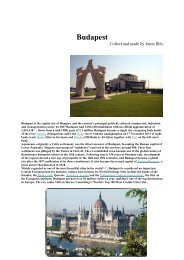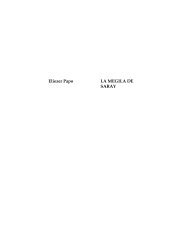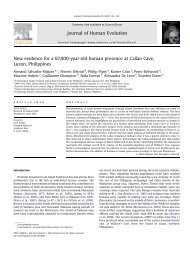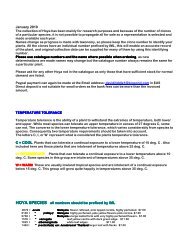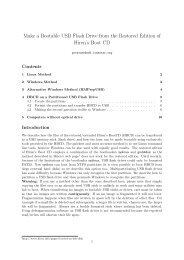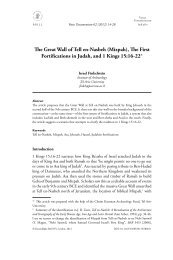ARTICLE IN PRESS Journal of Human Evolution
ARTICLE IN PRESS Journal of Human Evolution
ARTICLE IN PRESS Journal of Human Evolution
You also want an ePaper? Increase the reach of your titles
YUMPU automatically turns print PDFs into web optimized ePapers that Google loves.
8<br />
Table 4<br />
Body mass (kg) (fossil estimates) for modern and fossil Cercopithecinae.<br />
Species Sex Body mass (kg) (fossil estimates) Known age range<br />
Modern genera Cercopithecus _ 1.8–8.0 Extant<br />
\ 1.8–5<br />
Macaca _ 4.9–17.5 Extant<br />
\ 3.05–14.1<br />
Mandrillus _ 27–45 Extant<br />
\ 10–17<br />
Papio _ 15–37.2 Extant<br />
\ 8.8–20.5<br />
Theropithecus _ 16.5–20.25 Extant<br />
\ 9–13.8<br />
Fossil species Paradolichopithecus avernensis _ 25–41 2.5–1.6 Ma<br />
\ 12–23<br />
Theropithecus oswaldi oswaldi a<br />
_ 20–86 2.5–1.2 Ma<br />
\ 13–36<br />
Macaca sylvanus (fossil) _ 10–17 Late Miocene – Early Pleistocene<br />
\ 6.5–12.5<br />
Macaca sylvanus (from ‘Ubeidiya) \ 6.5–9.5 1.6–1.2 Ma<br />
ones. Misclassifications <strong>of</strong> the DFA were very low between these<br />
two groups. Therefore, the null hypothesis was rejected with a high<br />
degree <strong>of</strong> probability, and UB 330 was assigned to a large Cercopithecinae<br />
previously unidentified in ‘Ubeidiya. All previous Pleistocene<br />
cercopithecid material in the Levant has been attributed to<br />
the small-bodied Macaca sylvanus, and UB 330 represents the<br />
finding <strong>of</strong> a new taxon in the Early Pleistocene <strong>of</strong> the Southern<br />
Levant.<br />
Assignment to genera within the large-bodied Cercopithecinae,<br />
Papio, Paradolichopithecus, orTheropithecus, is more difficult based<br />
on the current data set but some taxa are more probable, based on<br />
morphology, body size, and biogeography.<br />
Do the data support an assignment <strong>of</strong> UB 330 to the genus Papio?<br />
<strong>ARTICLE</strong> <strong>IN</strong> <strong>PRESS</strong><br />
The question <strong>of</strong> the identification <strong>of</strong> UB 330 is very interesting<br />
from a biogeographic point <strong>of</strong> view. Papio hamadryas hamadryas is<br />
the only Papio to disperse beyond the African continent. It is<br />
currently found in the south <strong>of</strong> the Arabian Peninsula in the<br />
republic <strong>of</strong> Yemen and Saudi Arabia (Harrison and Bates,1991). Two<br />
alternative (although not mutually exclusive) routes have been<br />
suggested for the dispersal <strong>of</strong> Papio from Africa to Arabia: 1)<br />
a longer route, which includes a dispersal northward though the<br />
Nile valley and Sinai Peninsula into the Levant and then southward<br />
to the Arabian Peninsula, and 2) crossing the Bab el Mandeb strait<br />
during periods <strong>of</strong> low sea levels (Kummer, 1995). The finding <strong>of</strong><br />
Papio in the Early Pleistocene Levant would provide support for the<br />
former northern route.<br />
Evidence presented in this study does not provide strong<br />
support for the assignment <strong>of</strong> UB 330 to the genus Papio. While UB<br />
330 falls within the body size range <strong>of</strong> both modern and fossil<br />
Papio species (Delson et al., 2000), DFA could assign UB 330 to<br />
Papio with a median probability <strong>of</strong>




